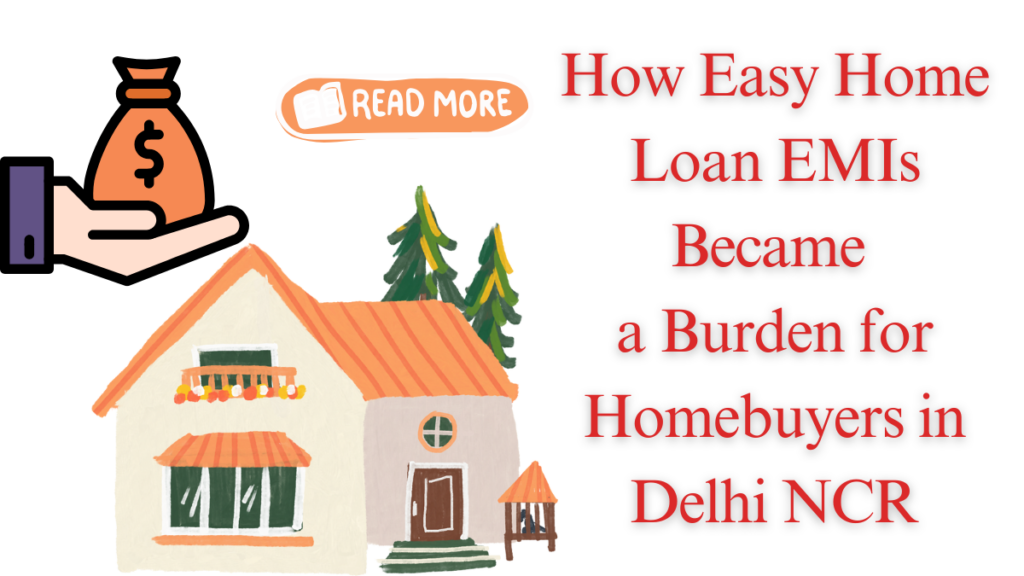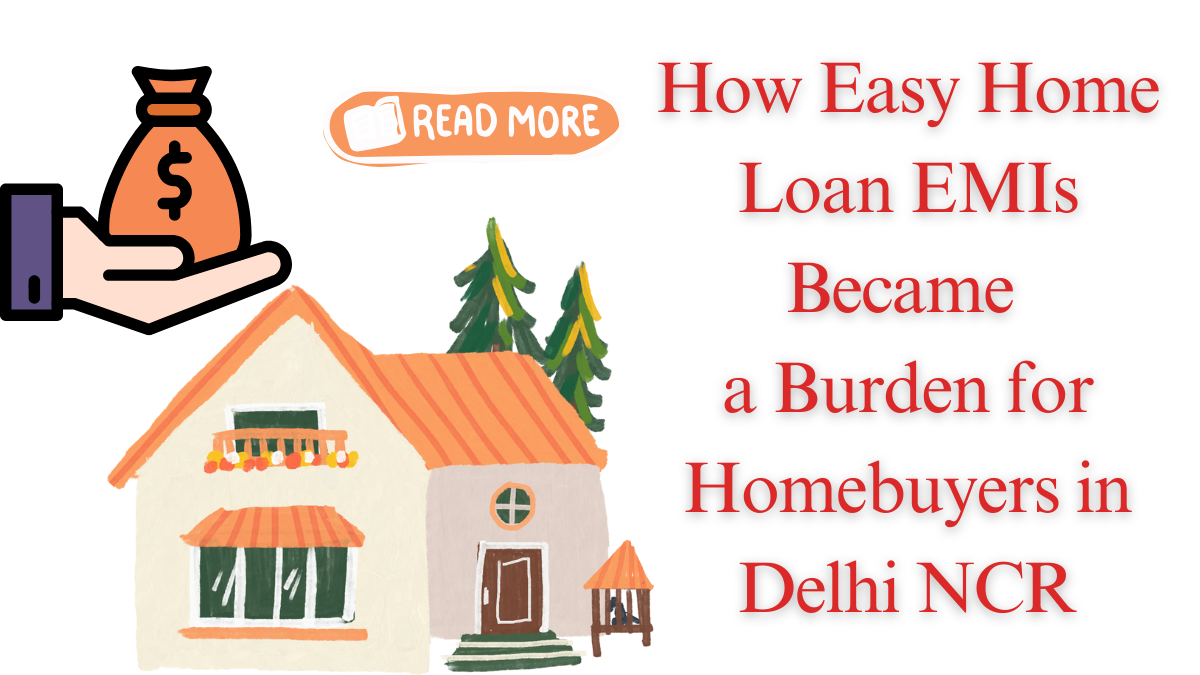In recent years, home loans in Delhi NCR (National Capital Region) were marketed as the ideal way for many to own a home. Offering attractive EMI (Equated Monthly Installment) schemes, these loans seemed like a dream come true for first-time homebuyers. However, the reality of these “easy EMI” schemes has turned into a nightmare for many as the financial burden has begun to spiral out of control for a large number of borrowers.

The Promise of Easy EMIs
The rise in demand for home loans in Delhi NCR was fueled by several home loan providers offering low-interest rates and easy EMI schemes. These loans were marketed aggressively with the promise of affordable monthly payments, making homeownership a reality for many middle-class families who previously struggled to afford a home.
- Initial Promise: Lenders promoted low EMI rates initially, making the loans look accessible, even for those without high incomes.
- Deferred EMIs: In some schemes, borrowers were offered the option to defer principal payments for a few years, lowering the EMI burden in the short term.
For many, it seemed like a perfect deal: buy a home with minimal upfront costs and pay off the loan in manageable, easy-to-handle installments.
The Reality of Rising Costs
However, over time, several borrowers in Delhi NCR have found themselves struggling to meet their EMIs. As the interest rates have increased, many are now seeing a dramatic rise in their monthly payments, making it harder for them to afford their homes.
- Interest Rate Hikes: Most of the “easy EMI” loans were initially offered at fixed low rates, but many of these loans have now switched to floating rates, which have seen significant hikes due to rising inflation and RBI monetary policies.
- Increased Monthly Payments: As interest rates increased, the monthly payments have risen by as much as 30-40% in some cases, putting a severe strain on borrowers’ finances.
For many homebuyers, their original understanding of affordable EMIs was shattered as they found themselves paying much more than they initially agreed to. This increase has been especially challenging for buyers who had taken loans based on their previous income levels, which have not seen corresponding increases.
The Loan Trap
In addition to the increasing EMI burden, another concern with these home loan schemes is that many borrowers are now stuck in long-term debt traps due to high interest rates and inflated principal amounts.
- Negative Equity: Several homebuyers are now in a situation where their outstanding loan balance exceeds the current value of their property. This is a phenomenon known as negative equity, and it can make it extremely difficult for homeowners to sell their properties or refinance the loan.
- Longer Loan Tenures: To combat rising EMI amounts, many homebuyers have extended their loan tenures, sometimes by 10 to 15 years, to keep the monthly payments affordable. This, however, increases the total amount paid over the life of the loan due to compounded interest.
The Strain on Borrowers
For many borrowers, the increase in EMI payments is not just a financial burden but has also led to emotional and mental distress. The dream of owning a home has now turned into a constant struggle to meet loan repayment deadlines.
- Stress and Anxiety: Borrowers are facing immense pressure due to the rising EMIs, often leading to anxiety and stress. The financial strain has disrupted the lifestyle of many families who are now unable to afford basic necessities while juggling home loan repayments.
- Risk of Foreclosure: Many homebuyers fear losing their homes due to the inability to make timely payments. Foreclosures have become a common occurrence, with banks and financial institutions taking legal action against those who default on their loans.
Key Factors Behind the Crisis
Several factors have contributed to the home loan crisis in Delhi NCR, turning what seemed like an opportunity into a financial nightmare for many borrowers.
- Rising Inflation: With inflation pushing up living costs, homebuyers have found it increasingly difficult to manage their EMIs along with daily expenses.
- Interest Rate Increases: As the Reserve Bank of India (RBI) raised interest rates to curb inflation, floating rate loans saw significant hikes in EMI amounts, increasing the financial pressure on borrowers.
- Unrealistic Promises: The initial marketing campaigns often promised low EMIs without explaining the long-term impact of interest rate hikes and the risks involved. Many buyers found themselves unprepared for the real cost of their loans.
The Way Forward
To address the situation, it is important to take a closer look at how home loan products are being marketed and sold to consumers. While home loans are undoubtedly essential for facilitating homeownership, transparency and clear communication regarding repayment terms are crucial.
- Financial Education: A greater focus on financial literacy is needed to ensure that borrowers fully understand the implications of their loan agreements before signing. Many homebuyers were not aware of the long-term impact of floating interest rates and other potential financial risks.
- Government Intervention: Policymakers may need to explore regulatory measures that ensure home loans are not excessively burdensome for borrowers. This could include measures to cushion borrowers against interest rate hikes or providing more flexible repayment options.
- Loan Restructuring: Banks and lenders should consider providing loan restructuring options to help borrowers cope with rising EMIs. Offering extended loan tenures or reduced interest rates for a certain period could provide much-needed relief.
Conclusion
What initially appeared to be an opportunity for first-time homebuyers in Delhi NCR has quickly turned into a financial nightmare for many. Rising interest rates, inflated EMIs, and the lack of awareness about loan structures have left many borrowers in dire straits. For the dream of homeownership to remain attainable, it is crucial that both lenders and borrowers are more transparent, informed, and mindful of the long-term financial impact of home loans. Homebuyers must also ensure they have the necessary tools and resources to make informed decisions when taking on large financial commitments such as home loans.
People May Ask
Why are homebuyers in Delhi NCR struggling with home loan EMIs?
Homebuyers in Delhi NCR are facing increasing EMI burdens due to rising interest rates, which have resulted in a significant hike in monthly payments. Additionally, many borrowers were not fully aware of the long-term impact of floating rate loans.
How have interest rate hikes affected home loan repayments?
Interest rate hikes by the RBI have caused floating rate loans to become more expensive, with many homebuyers seeing an increase of 30-40% in their monthly repayments, putting additional strain on their finances.
What is negative equity?
Negative equity occurs when the outstanding loan balance exceeds the current market value of the property. Many homebuyers in Delhi NCR are now in negative equity, making it difficult for them to sell or refinance their homes.
What can be done to help struggling homebuyers?
Financial education, transparent loan agreements, government intervention, and loan restructuring options are some measures that could help struggling homebuyers. These steps would provide borrowers with more flexibility and reduce the financial strain caused by rising EMIs.
Click here to learn more.
Pari is a passionate writer known for captivating stories that blend imagination and reality. Inspired by travel, history, and everyday moments, Pari crafts narratives that resonate deeply with readers.
